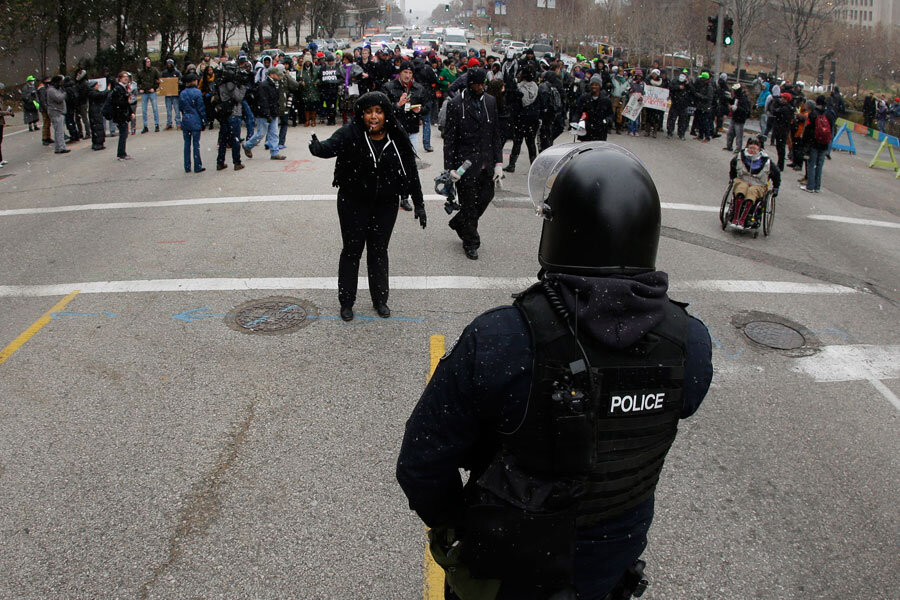Protested and provoked, police show restraint in Ferguson
Loading...
| St. Louis and Ferguson, Mo.
While the nation reacted with shock after Monday's images of raging fires and rampant looting in Ferguson, Mo., somewhat overlooked has been the restraint shown by area police toward hundreds of peaceful protesters – even those engaging in civil disobedience.
Monday night did not go as planned, with only about 700 members of the National Guard deployed, mostly after the violence had already spiraled out of control. There were conflicting reasons for the late deployment, but Unified Command clearly wanted to avoid the controversial militarized police response of the Ferguson Police Department in the immediate aftermath of Mr. Brown's death.
Although a few scattered fires and smashed windows occurred Tuesday, it was a "much better night," said St. Louis County Police Chief Jon Belmar early Wednesday morning. "We saw some protesters out there that were really out there for the right reason."
Police were bolstered by more than 2,000 members of the Missouri National Guard Tuesday. While the numbers were “perhaps alarming to some folks, I think at the same time it’s probably comforting to some, because it allows us to gain that measure of control,” Chief Belmar said.
In the weeks leading up to Monday's grand jury decision, in which police offer Darren Wilson was not indicted for killing black teenager Michael Brown, police had sought to foster "the most ideal" response to anticipated protests. That effort now appears to be paying off in Ferguson and across the area.
Leaders from protest groups and the St. Louis County Unified Command of local departments sat down to discuss what to expect from each other. Protest leaders had a list of 19 "rules of engagement," half of which the police generally agreed to follow, also telling protest leaders what to expect from them.
On Tuesday night, police closed off the area near the site of Brown's shooting, which had been allowed to remain open to protesters the night before. A few protesters marched to city hall, smashing windows and flipping over a police cruiser while trying to set it ablaze. But police were able to disperse the crowd with only one volley of tear gas.
Earlier Tuesday afternoon, the Unified Command's restrained approach to boisterous protests was perhaps even more apparent.
A noisy protest of around 700 to 1,000 marchers began at Kiener Plaza near the famous St. Louis Arch around noon. Protesters marched through the streets for hours, passing Busch Stadium and chanting anti-police slogans. Dozens of police officers, including many on bicycles, remained nearby but kept their distance, often lingering a block away.
When the protest reached the city's historic Lacledes Landling, half the group marched up the entrance of the Martin Luther King Bridge, shutting it down in both directions for more than 10 minutes. The other half formed a large circle in the middle of a busy intersection leading to ramps to the interstate highway roaring above.
Dozens of police watched but did intervene, and protesters dispersed on their own.
Next, the protesters tried to shut down the interstate itself. They approached the ramp to Interstate 70, but a cadre of about 30 police in riot gear blocked the north exit ramp. The southbound exit ramp, however, remained open, and protesters began to march up to the highway.
Officers did not attempt to stop them as hundreds entered, shutting the interstate down in both directions. For at least a half hour, hundreds of protesters chanted while blocking traffic. A few at the front of the crowd threw objects, and there were at least three arrests as police responded with pepper spray on a half dozen of the most aggressive.
Finally, a few dozen police moved in slowly, with some tapping the ground with their service batons and plastic shields. The crowd fell back and the episode ended with no mass arrests. Protesters went on their way into the city again.
"We did it! We did what we wanted to accomplish," said La'Brimore Aikens, a student who joined the protest jubilantly when it passed Lacledes Landing and then remained at the front of the fray.
The police might have had the same reaction.








